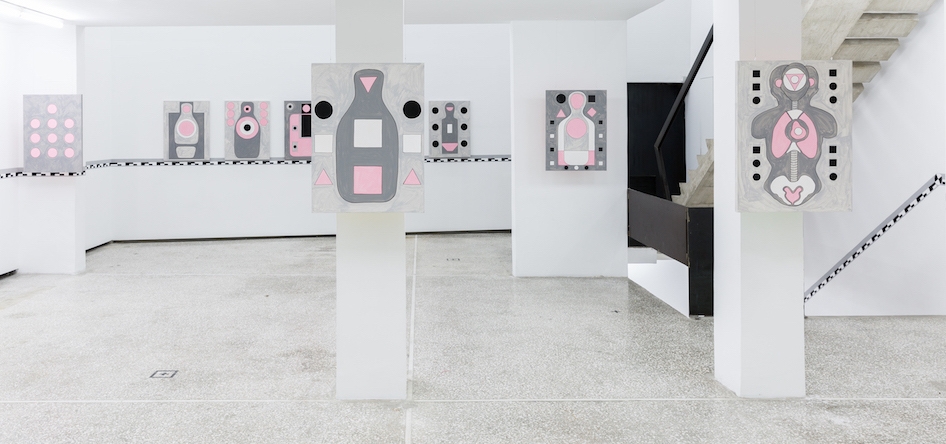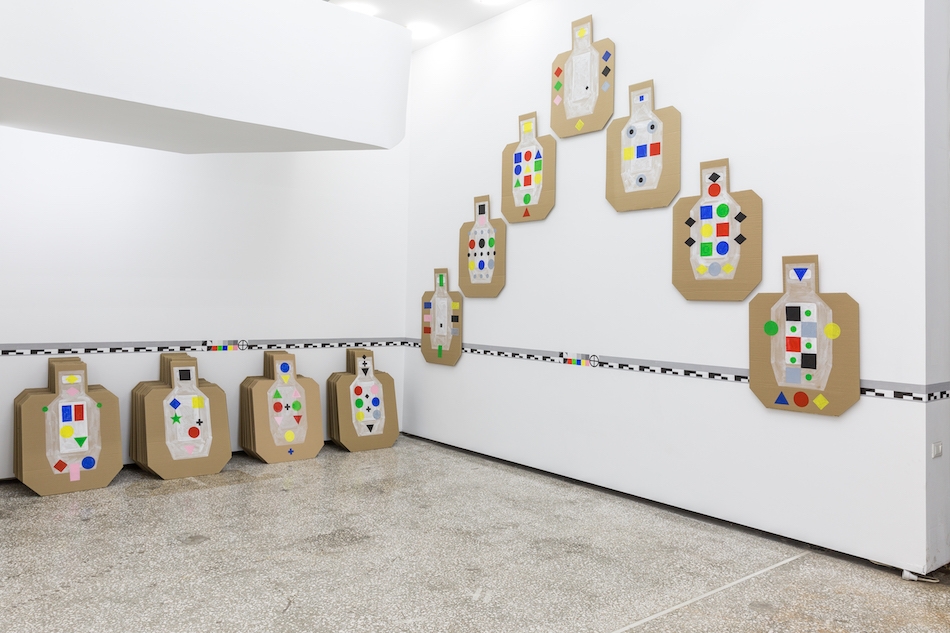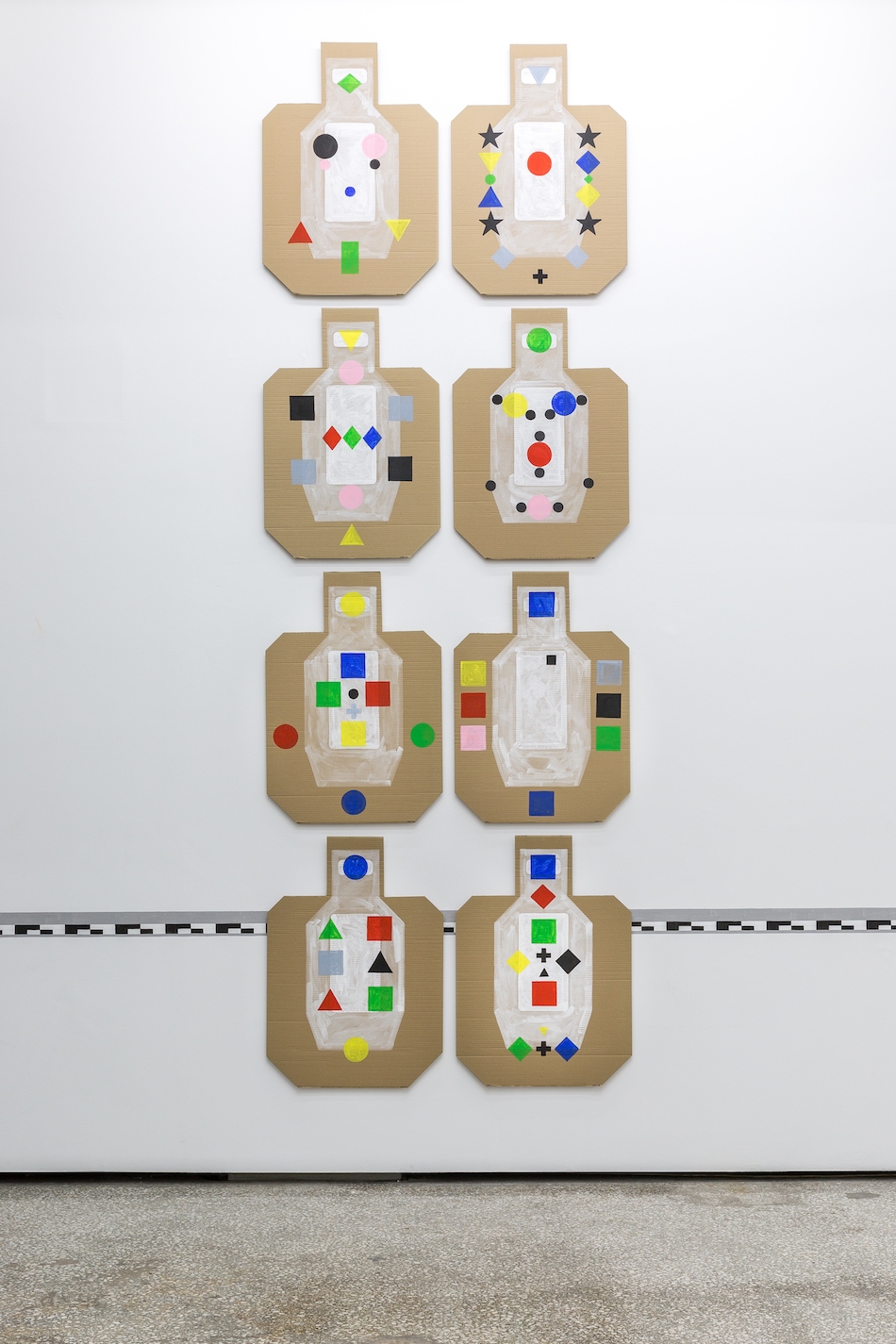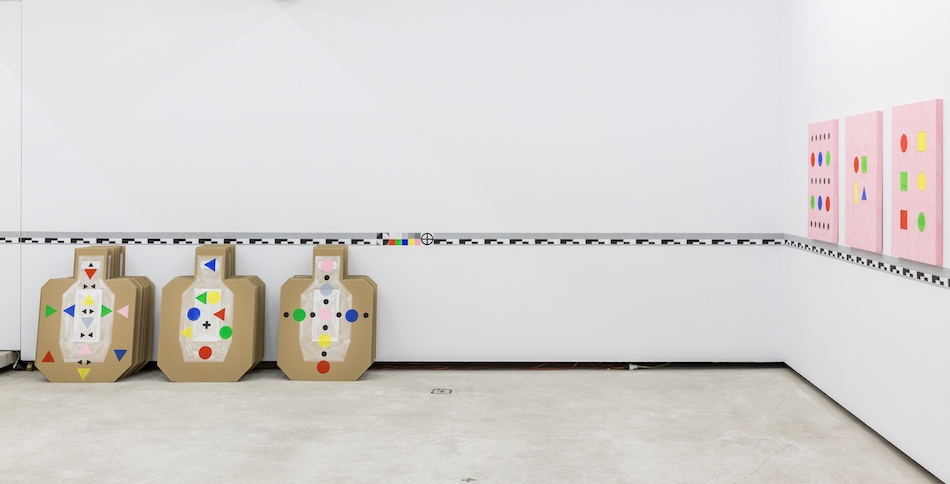Navine G. Dossos
Shoot the Women First
February 8, 2018–March 10, 2018The Breeder, Athens
The Breeder is pleased to present Shoot the Women First a solo exhibition by Navine G.Dossos.
Shoot the Women First was reputedly the direction given in the 1980s to members of West Germany’s elite GSG-9 anti-terrorist squad. It subsequently became standard advice offered by Interpol to other European agencies in the wake of the Baader-Meinhof, Red Brigade, IRA and other paramilitary attacks carried out by groups including female terrorists.
The paintings in this exhibition reflect on the role of women regarded by society as both perpetrators and victims of violence, questioning what it means to be both a menace and a target. The violence represented is not merely physical, but embodies a wider threat to society by those who exist on the periphery of mainstream politics and culture.
These works draw on a heterogeneous range of historical, ongoing and future scenarios. Within the Greek context, they were shaped by the 2012 arrests of female drug-users suspected of doing casual sex work in Athens, the forced HIV testing of these women, and the imprisonment of those with a positive test result, accused of grievous bodily harm (GBH) by transmitting the virus. The release of the suspects’ personal information by the police to the media led to further stigmatisation and terrorising of female sex workers and women living with HIV.
The ongoing imprisonment of Irianna under Greece’s questionable counter-terrorism law, albeit the evidence being in dispute is also an important point of reference. The unchecked use of guns against civilians by the police in the US has been another major influence, as have the recent social media campaigns drawing attention to the widespread and normalized sexual harassment of women on a global scale. In each scenario, forms of terrorism and bioterrorism mingle, and viruses and virality emerge as weapons.
The paintings reference several symbolic systems and languages, from the distinct shade of pink which demarcates the brothels of central Athens, to the brightly coloured shapes of ‘discretionary command’ training targets that abstract and standardize the human body as a series of points to be shot. ‘Discretionary command’ training requires the shooter to listen to commands and shoot the shapes and colours in a given order. This system complicates responsibility for the act of shooting: the person giving orders, or the person holding the gun. The paintings dramatise the impulse to standardize and control bodies that frighten or threaten the state, by abstracting and processing them as diagrams and targets.
Shoot the Women First is laid out across two floors in the style of a shooting gallery. Made up of three distinct sets of work, the materials of the paintings highlight the divide between that which is ephemeral and that which is permanent, and the corresponding value we place upon each. The works on cardboard (Bulk Targets 1-100, 2018) take their shape and number from the International Practical Shooting Confederation shooting target model, often sold in packs of one hundred. They are used once and discarded. In contrast, the works in Pink Discretionary Command I-XII and Grey Discretionary Command I- VIII are made on gesso panels, the traditional technique of icon painting, and share in the language of this sacred object, which is kept safe and venerated.
The wall painting that joins the two floors of the exhibition together is based on a standard forensic ruler: a tool used at crime scenes to assist forensic photography and provide scale and colour calibration for evidence documentation.
she refused to be what she was told she was (2018) is a site specific performance choreographed by Yasmina Reggad that activates Bulk Targets 1-100 . The performance is titled after the last words of Lisa Downing’s essay ‘Shoot The Women First. A Reflection on the Gender Politics of Targeting’ (2018) specially commissioned by the artist. The costumes are taken from among the first studies for Bulk Targets 1-100. As the dancers-as-shooting-targets shield one side of their bodies, this group of individuals becomes on one hand the coercive ‘army’ that divides and conquers, and on the other, the threatening objects to be targeted. The group will perform ambiguous characters and stereotyped ideas projected onto women from different angles, blurring the boundaries between victim and perpetrator. Both the gallery space and the pedestrian street are under siege and transformed into a stage and a battlefield. Members of the audience are the witnesses or accomplices of either the oppressed or the persecutors. The heels hitting the ground awake one’s memory of a lonely woman walking an empty street, a rushed roadside solicitation – or maybe this is the call for an uprising.
Navine G. Dossos (b. 1982, London) is a visual artist, based in Athens. Her interests include Orientalism in the digital realm, geometry as information and decoration, image calibration, and Aniconism in contemporary culture.
Dossos studied History of Art at Cambridge University, Arabic at Kuwait University, Islamic Art at the Prince’s School of Traditional Art in London, and holds an MA in Fine Art from Chelsea College of Art & Design, London. In 2014/2015, she was a participant at the Van Eyck Academie in Maastricht. She has exhibited and worked with various institutions, including The Museum of Islamic Art (Doha), Witte de With (Rotterdam), The Van Abbemuseum (Eindhoven), The Delfina Foundation (London), The Library of Amiens (Amiens), Leighton House Museum (London), The Benaki Museum (Athens) and the A.M. Qattan Foundation (Ramallah).
Yasmina Reggad, she refused to be what she was told she was (2018)
(Choreography & research: Yasmina Reggad; Yi Quan training & movements: Paola-Rebecca Drea; Costume: first studies for Bulk Targets 1-100 (2017) by Navine G.Dossos; performed by dancers Mina Ananiadou, Ioanna Angelopoulou, Marilina Besi, Paola-Rebecca Drea, Veatriki Kapnisi, Dafni Krazoudi, Marina Miliou-Theocharaki, Elton Petri, Alexandra Tsotanidou and Valentini-Eleni Vekkini; Photography: Alexandra Masmanidi)




